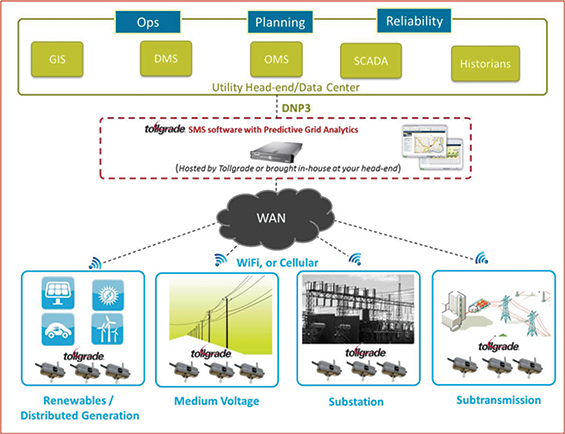Ten years ago an overgrown tree near Cleveland, Ohio started a chain reaction that caused the blackout of 2003, a cascading power failure that caused most of the Northeastern United States and neighboring parts of Canada to lose power. The blackout left approximately 50 million people without power. It was a power failure that shut down 265 power plants, with 508 generating units, including 10 nuclear power stations, rapidly spreading across North America.
In its final report on the causes of the blackout of 2003, the U.S.- Canada Power System Outage Task Force identified poor vegetation management, computer failures, inadequate training and lack of real-time situational awareness of grid conditions as the main factors behind the disaster. The task force also identified institutional failures across the industry, particularly in setting and enforcing reliability standards, and coordinating across the grid.
This catastrophe provides an important example of how vulnerable our modern economy is to disruptions on the power grid but the 2003 Blackout is not alone. On the tenth anniversary of the Blackout, the Department of Energy (DOE) and the White House published their report ‘Economic Benefits of Increasing Electric Grid Resilience to Weather Outages’ where they found that seven of the costliest storms in U.S. history occurred after the Blackout. These ‘billion dollar’ storms have had a devastating effect on the economy and society. Outage profiles of these storms reveal a similar pattern: utilities attempt to restore power to the majority of customers relatively quickly, while a substantial number of customers remain without power long after the event occurred. What we’ve learned is that the longer it takes to restore power, the higher the cost to customers and the economy. In the case of Super Storm Sandy, losses have been estimated to be as high as $65B and 50 of the 72 people who died in this storm were directly attributed to power outages.
By their own definition in the DOE and White House report, ‘A more resilient grid is one that is better able to sustain and recover from adverse events like severe weather – a more reliable grid is one with fewer and shorter power interruptions.’ With restoration taking anywhere from 3 to 20 days during an average storm, what can be done to increase the reliability and resilience in our grid moving forward?
Investments in the Distribution Network Will Help
Restore Power Faster and Build a More Resilient Grid
In North America, the distribution part of our electric grid is the largest part of a utility’s network spanning over six million miles. According to the Edison Electric Institute (EEI), it’s also where over 90 percent of the outages in the U.S. occur. Yet, it is largely unmonitored and historically has been underfunded. Utilities have little to no visibility or real-time situational awareness into this part of the grid.
The technology to improve situational awareness and reliability is available. A new breed of software-driven smart grid sensors built for the distribution network have the ability to improve situational awareness by communicating real-time grid health data back to utilities to help them locate and restore outages faster.
This technology goes much deeper than smart meters, which are located at the home and can only tell if a customer has power or not. Pinging smart meters after power has been restored has been shown to be a valuable way to confirm that the crew’s work to restore outages has been successful; however meters alone cannot identify failure locations in the distribution part of the network. Smart grid sensors on the distribution network are often much closer to the point where the majority of outages occur and provide better outage location information back to utilities to focus their repair efforts.
The breakthrough in making this an affordable and viable option for utilities came recently. In large part it’s been the ability to provide the sensors with flexible and reliable wireless communication paths (e.g. Wi-Fi, WiMAX, and cellular) to span the millions of miles of unmonitored distribution lines and provide utilities with the real-time situational awareness they need to combat outages (see Figure 1).

Figure 1: Next Gen Smart Grid Sensor Distribution Network
Smart Grid Sensors on the Distribution Network
Can Prevent Non-Storm Related Outages
As the 2003 blackout taught us, not all significant outages are storm-related – they can be caused by vegetation overgrowth, or stress from too much load on the system. But, it’s also our aging infrastructure that is causing a good portion of non-storm related outages. It’s estimated that 25 percent of outages are caused by failing equipment. So what if the grid were smart enough to tell the utility of vegetation overgrowth or equipment failure before they caused outages?
This new breed of smart grid sensors has predictive capabilities that can capture vital ‘fault signatures’ from the grid to assess the health of the network and important assets like substation transformers or hydraulic reclosers. By creating a library or database of ‘fault signatures,’ utilities can be in a position to predict and correct problems before they occur.
This is becoming hugely important as the grid ages. Today, it is estimated that 70 percent of transformers are over 25 years old and quickly reaching their end of life. When these assets fail, outages occur. By having the vital knowledge of these failures before they happen, utilities could prevent more of these types of outages. While this may sound futuristic, this concept has worked in other industries like the computer security industry where having a library of signatures from known viruses and malware has helped prevent attacks. Only recently has this concept been applied to improve grid reliability.
The foundation of a predictive grid is being researched and embraced at a variety of the world’s leading utilities such as Duke Energy and CenterPoint in the U.S., Toronto Hydro in Canada and Western Power Distribution in the United Kingdom. These utilities are deploying Tollgrade smart grid sensors with Predictive GridSM Analytics that are accurately detecting and classifying faults that cause outages in real-time. For example, in two very large deployments in North America, the signature to detect blown fuses on laterals is being used to report outages 20 to 30 minutes before a customer calls. All events are linked to map-view displays that make it easy for utilities to pinpoint the locations of problems for quick response and resolution.
Toronto Hydro, the largest municipal electricity distribution company in Canada, eliminated 550,000 customer outage minutes with sensors operating on two feeder lines alone. Think of the positive impact this could have if applied across the larger distribution network. Ivano Laboricca, Toronto Hydro’s vice president of asset management said, “From an asset manager’s perspective, this technology will allow us to know immediately if there is a problem that is easy to fix or if it is a serious problem that requires capital investment.”
It is imperative that we begin to target the necessary distribution grid modernization upgrades that require future investments to ensure a safe and reliable supply of energy.
By having the situational awareness, the use of smart grid sensors with Predictive Grid Analytics will be much more effective than smart meters in finding the causes of outages on the distribution-side of the network. The net benefit to all will be the ability to restore power faster in storms. Finally, as this technology matures, utilities will have an arsenal of known ‘event signatures’ that will help them predict equipment failures or other non-storm related events that cause outages and stop their propagation before they turn into massive rolling blackouts.
About the Author
 As a driver of global telecommunication transformation, Edward H. Kennedy has been recognized for his ability to build innovative, high-growth companies. Probably best known as the CEO and President of Ocular Networks, a company he co-founded. As President and CEO of Tollgrade Communications, Ed is putting his experience transforming the telecommunications industry to work by helping utilities modernize their nation’s power grid.
As a driver of global telecommunication transformation, Edward H. Kennedy has been recognized for his ability to build innovative, high-growth companies. Probably best known as the CEO and President of Ocular Networks, a company he co-founded. As President and CEO of Tollgrade Communications, Ed is putting his experience transforming the telecommunications industry to work by helping utilities modernize their nation’s power grid.
Ed has held several executive level positions at Tellabs, Ocular Networks, Rivulet Communications, Alcatel and Newbridge Networks and board positions at Hatteras Networks, Imagine Communications, Visual Networks (acquired by Danaher Corporation NYSE: DHR) and Extreme Networks (NASDAQ: EXTR). Working with Virginia’s Governor Mark Warner and the Appalachian Regional Commission in 2003, Ed is a staunch advocate of the importance of telecommunications in Rural Development. Ed is a graduate of Virginia Polytechnic Institute with a Bachelors of Science degree in Electrical Engineering.







